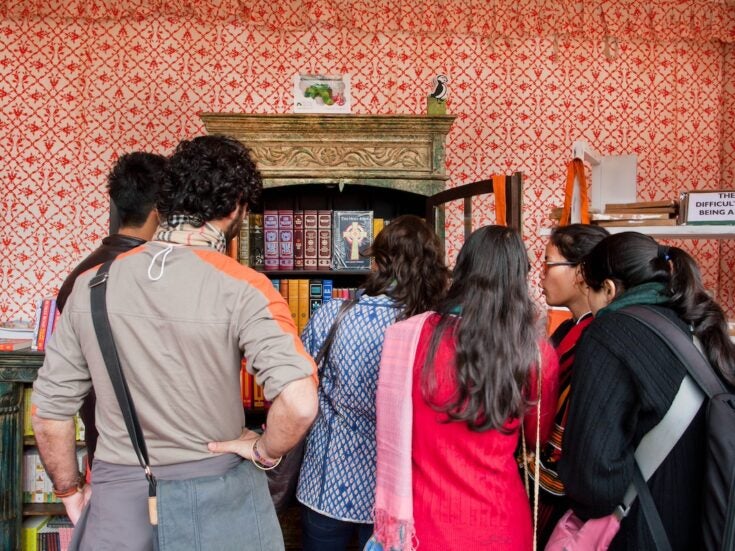
Once monuments to functionalism and economy, hospitals are now a showcase for the best in contemporary art — and philanthropists and collectors are at the heart of the action, says Simon Lord
PHILIP LARKIN’S POEM The Building compared the solemn interior of a hospital to that of a cathedral — where we step outside our daily lives to confront our mortality. Hospitals are where we begin and end, where babies come from and the dying go, where medical miracles occur.
During the past century, however, they became homogenised, functional waiting rooms for the hereafter. No longer. New ways of using hospital spaces place art at the heart of care, and provide exciting opportunities for high-net-worth philanthropists looking to do something more meaningful with their arts spend.
The origins of Britain’s public hospitals can be found in the potent fusion of religion and philanthropy. The oldest, the venerable St Bartholomew’s in Smithfield, was founded in 1123 by a courtier of Henry I after the titular saint instructed him to build a paupers’ hospital. Barts has been funded for most of its history by subscriptions from the wealthy men and women whose names line the Great Hall — the staircase of which was painted (for free) by William Hogarth.
This changed following the Second World War, as nationalisation made hospital-building the preserve of the state. While free healthcare for all was a great humanitarian leap forward, a side effect was that hospitals had to be thrown up at minimal cost, with the aesthetic of the buildings coming a distant second.
‘From the Fifties to the Eighties there was a perception that any money that wasn’t nailed down in medical equipment or staffing was money wasted,’ says Anne Mullins, director of Vital Arts, the charitably funded organisation that curates the arts programme at Barts and the London NHS Trust.
‘And for the media this is the best kind of bad news story,’ she adds. ‘But people have become more and more sophisticated about these things, and they know that no one is going to choose between a nurse and a painting. They also know that you can’t build a structure that aims at curing people without thinking about the aesthetics of that space, and the impact it has on people’s care and how they feel.’

This change in cultural attitudes to the hospital environment mirrors the growing scientific consensus on the importance of non-medical factors in what the reports call ‘clinical outcomes’. These studies have grown in number and precision over the past two decades, using indicators from questionnaires to MRI scans to determine the medical effects of creative art and the aesthetic environment.
These studies consistently found that non-clinical inputs, such as printed screens used to shield the surgical equipment in delivery rooms, had statistically significant clinical outcomes — indicators such as decreased requests for analgesics by women in labour. Hospitals with dynamic visual arts programmes also experience less staff turnover.
The works themselves can also have sound medical applications: Barts installed light boxes by well-known artists including Darren Almond and Simon Patterson on the ceilings above linear accelerator machines (linacs), where they provide both a focus and a meditative experience for patients receiving radiotherapy treatment who have to remain still for long periods.
It’s exactly these kinds of specialised settings and uses of the work that require a strong curatorial direction. ‘Nearly everything we commission is site-specific, so it’s all about the space and the context,’ explains Catsou Roberts, commissions curator with Vital Arts. ‘This allows the artists to really push the relationship between the work of art and the peculiarities of the hospital environment.’ She indicates a silhouetted tree by Oona Culley, the branch of which curls playfully around a green fire exit sign.
MOVING THROUGH THE wards and waiting rooms at Barts, one notices that no two are alike. Some, like a hushed and meditative radiotherapy waiting room filled with an installation of works by Darren Almond, scarcely feel like hospital spaces at all. ‘This series of Darren’s Fullmoon images lends the space a sense of wonderment that is contemplative and transportative, which is something patients often want — to be taken out of the moment,’ muses Roberts.

The waiting room feels more like a quiet club, with its downcast lighting and Almond’s stunning, long-exposure landscapes with their eerie water and thick, misty air. ‘This is the calibre of artwork you’d see at an international art venue, but it’s here for people waiting for cancer treatment. One wouldn’t easily have the opportunity to view such an important collection of Darren’s works all in one place anywhere else.’
Almond’s mother worked for the NHS, and the hospital environment is one that resonated with him, as with many other artists. ‘Darren was really interested in the context, and we were stunned by his generosity,’ says Roberts. ‘He came down here when it was still a construction site, donned a hard hat and steel-tipped boots to meet with us and discuss the selection and installation of the works.’
This engagement with the artist and the space is what places the new wave of hospital arts programmes a long way from mere decoration; it’s also what makes them an intriguing proposition for donors and collectors. As Roberts adds: ‘What’s wonderful is when we push significant, international artists to work in ways they might not have otherwise, or find an emerging artist and watch their work develop through their commissions for us.’
This is what happened to Anka Dabrowska, a Polish-born artist whose 3D found-material collages of Warsaw’s street kiosks line the corridors of the new Cancer Centre — installed slightly lower than most art because many of the patients who pass through do so in wheelchairs. The new Cancer Centre at Barts also contains site-specific works by Hannah Collins, Richard Wentworth and Ilana Halperin, among others.
‘Artists get the opportunity to show their work in a unique public space,’ says Mullins, ‘and then we tour other curators and collectors, have the works photographed and generally ensure they get good exposure. Patrons and donors also get access to artists through events — things like panel discussions, awards and so on — so it’s a different way of investing in contemporary art.’

These arts programmes are funded entirely by private donors and chariable sources, meaning the fabled nurse-or-painting choice never comes up. The arts programme for the Breast Care Centre, which opened in a formerly derelict building at the heart of the Barts site in 2003, was funded by a single large donor, who also underwrote much of the cutting-edge medical equipment. The building contains entirely site-specific works by DJ Simpson, Cornelia Parker, George Shaw and David Batchelor. Shaw’s small paintings of his father’s house — characteristically domestic, detailed, warm and yet slightly off-kilter — are a specific reminder of home in the places where patients wait, alone, for their examinations.
As the medical benefits of art become more accepted, hospitals are opening up not only to projects such as Vital Arts, but also to major public works of art. When the Cancer Care Centre is complete, a four-storey atrium will look out into the heart of the City, with a correspondingly large-scale work of art that major artists are currently vying to produce.
‘A lot of people are shelling out money to help buy another Richter or Koons for the big museums, but they may be interested in opening up their portfolios and doing something more adventurous,’ says Mullins. ‘The hospital is a different and in some ways more valuable setting for an artwork, because the money you spend really resonates. Just because you get an illness, you don’t suddenly not need art or music, or a great aesthetic experience. If anything, you need these things more.’
Middle: One of Darren Almond’s Fullmoon works at Barts.
Bottom: A site-specific commission by Almond installed in the ceiling at Barts







